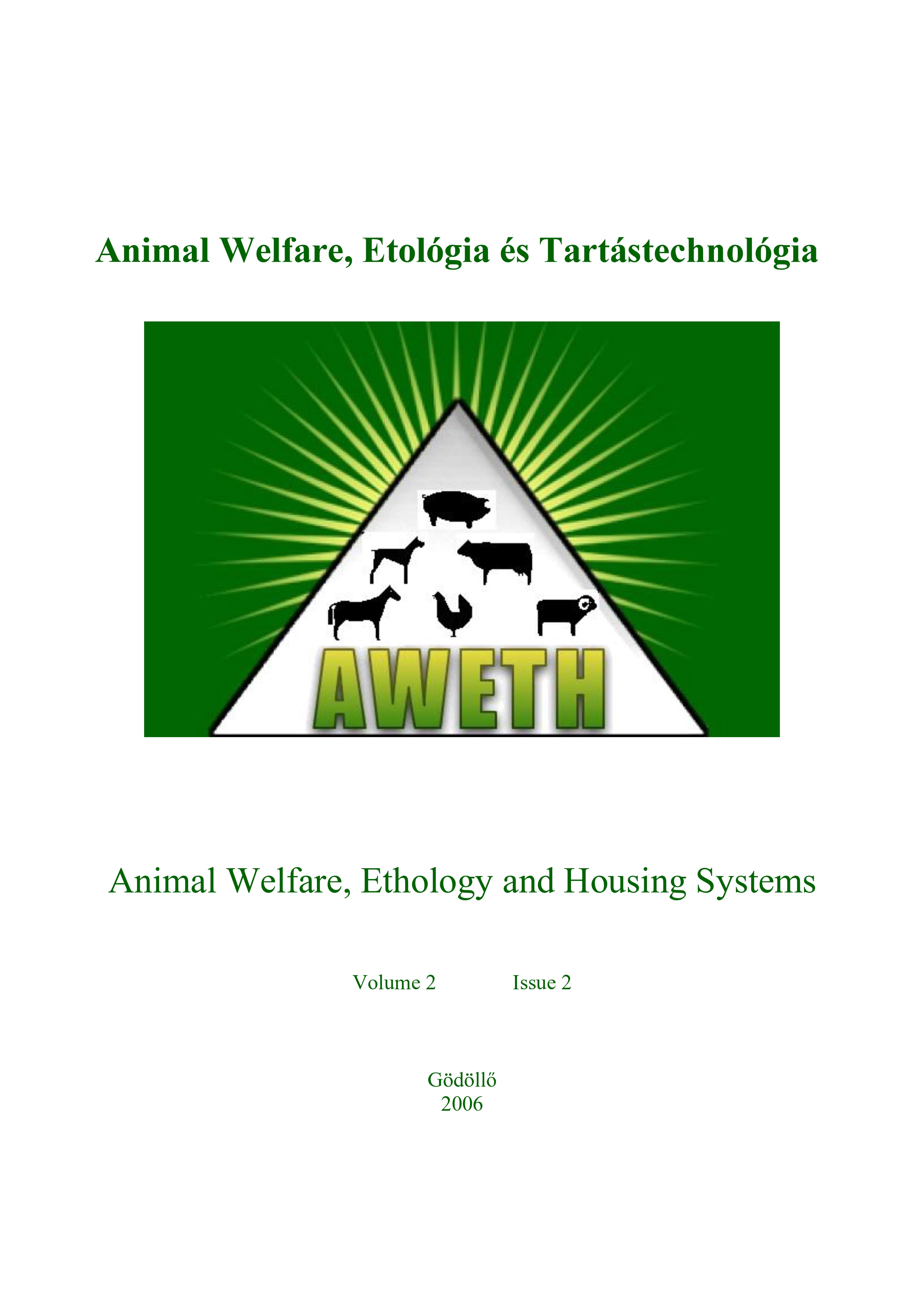A lótartás állatvédelmi kérdései
Tartástechnológia hatása a lovak jóllétére
Kulcsszavak:
viselkedési zavar, ló, tartástechnológia, állatvédelem, „aktív istálló” rendszerAbsztrakt
A szerzők összefoglalják a lovak számára nem megfelelő tartási körülmények következtében kialakuló viselkedési zavarokat, valamint az állatvédelmi szempontból elfogadható szükséges változtatásokat. Tárgyalják továbbá a helyes tartástechnológiai elemeket, melyek hatással vannak az állatok jóllétére, valamint az ún. „aktív istálló” alternatív tartási rendszert, amelyet a lovak természetes etológiai sajátosságait figyelembe véve alakítottak ki.
Hivatkozások
Bartos, Á., Bányai, A., Stiller, Sz. (2004): Lótakarmányozás és tartástechnológia. Oktatási segédlet CD-ROM
Bodó, I., Hecker, W. (1998): Lótenyésztők kézikönyve. 86–87.
Binder, A. (2005): Artgerecht mit Laufstallhaltung. Vet Journal, 58. 31–34.
British Horse Society (2006): Horse welfare leaflet
Broom, D. M. (1986): Indicators of poor welfare. British Vet. J., 142(6) 524–526. https://doi.org/10.1016/0007-1935(86)90109-0
Budiansky, S. (1997): A ló természetrajza. Vincze Kiadó, Budapest.
Butler-Wemken, I. (2006): Wenig Staub, wenig Husten. LZ Rheinland, Ausgabe 3, 40–43.
Cooper, J. J, McDonald L., Mills, D.S. (2000): The effects of increasing visual horizons on stereotypic weaving: Implications for the social housing stabled horses. Appl. Anim. Behav. Sci., 69(1) 67–83. https://doi.org/10.1016/S0168-1591(00)00115-5
Cooper, J. J., Mason, G. J. (1998): The identification of abnormal behaviour and behavioural problems in stabled horses and their realtionship to horse welfare: a comparative review. Eq. Vet. J. 30(Suppl. 27) 5–9. https://doi.org/10.1111/j.2042-3306.1998.tb05136.x
Hecker, W., Csizmadia, L. (2000): Lovardák, istállók tervezése, építése.
Hogan, E. S., Houpt, K.A., Sweeney, K. (1988): The effect of enclosure size on social interactions and daily activity patterns of the captive Asiatic Wild Horse (Equus przewalskii). Appl. Anim. Behav. Sci., 21(1–2) 147–168. https://doi.org/10.1016/0168-1591(88)90105-0
Houpt, K. A., Kusunose R. (2000): The genetic of the horse, 298.
Kusunose, R., Hatakeyama, H., Kubo, K., Kiguchi, A., Asai, Y., Fujii, Y., Ito, K. (1985): Behavioural studies on yearling horses in field environments. Bulletin of Equine Research Institute, 23. 1–6.
Luescher, U. A., McKeown, D. B., Dean, H. (1998): A cross-sectional study on compulsive behaviour (stable vices) in horses. Equi. Vet. J. 30(Suppl. 27) 14–18. https://doi.org/10.1111/j.2042-3306.1998.tb05138.x
Luescher, U. A., Mc Keown, D. B., Halip, J. (1991): Reviewing the causes of obsessive-compulsive disorders in horses. Vet. Med. 86. 527–531.
Mason, G. J. (1991b): Stereotypies and suffering. Behav. Proc., 25(2–3) 103–115. https://doi.org/10.1016/0376-6357(91)90013-P
Mayes, E., Duncan, P. (1986): Temporal patterns of feeding in free-ranging horses. Behaviour, 96. 105–129. https://doi.org/10.1163/156853986X00243
McAfee, L. M., Mills, D.S., Cooper, J. J. (2002): The use of mirrors for the control of stereotypic behaviour in stabled horses. Appl. Anim Behav. Sci., 78(2–4) 159–173. https://doi.org/10.1016/S0168-1591(02)00086-2
McBride, S. D., Cuddeford, D. (2001): The putative welfare reducing effects of preventing equine stereotypic bahaviour. Animal welfare, 10(2) 173–189. https://doi.org/10.1017/S0962728600023848
McDonnell, S. (2003): A Practical Field Guide to Horse Behavior. A Division of the Blood-Horse.
McGreevy, P. D., Cripps, P. J., French, N. P., Green, L. E., Nicol, C. J. (1995a): Management factors associated with stereotypic and redirected behaviour int he thoroughbred horse. Eq. Vet. J., 27(2) 86–91. https://doi.org/10.1111/j.2042-3306.1995.tb03041.x
McGreevy, P. D., French, N. P., Nicol, C. J. (1995b): The prevalence of abnormal behaviours in dressage, eventing and endurance horses in relation to stabling. Vet. Rec., 137(2) 36–37. https://doi.org/10.1136/vr.137.2.36
Mills, D. S., Nankervis, K. J. (1999): Equine Behaviour: Principles & Practice. Blackwell Scientific Publications, Oxford, UK.
Mills, D. S. (2002): Recent Advances in the Treatment of Equine Stereotypic Behaviour. Contents of a Dorothy Russell Havemeyer Foundation Workshop – Horse Behavior and Welfare
Nicol, C. J. (1999): Understanding equine stereotypies. Eq. Vet. J. Suppl., 31(Suppl. 28) 20–25. https://doi.org/10.1111/j.2042-3306.1999.tb05151.x
Pedersen, G. R., Sondergaad, E., Ladewig, J. (2004): The influence of bedding on the time horses spend recumbent. J. Equine Vet. Sci., 24(4) 153–158. https://doi.org/10.1016/j.jevs.2004.03.013
Rafai, P. (2003): Állathigiénia, 290–294.
Redbo I., Redbo-Tortensson P., Odberg, F. O., Hedendahl, A., Holm, J. (1998): Factors affecting behavioural disturbances in race horses. Anim. Sci., 66(2) 475–481. https://doi.org/10.1017/S1357729800009644
Rivera, E., Benjamin, S., Nielsen, B., Shelle, J., Zanella, A. J. (2002): Behavioral and physiological responses of horses to initial training: the comparison between pastured versus stalled horses. Appl. Anim. Behav. Sci., 78(2–4) 235–252. https://doi.org/10.1016/S0168-1591(02)00091-6
Sondergaad, E., Ladewig, J. (2003): Group housing exerts a positive effect ont he behaviour of young horses during training. Appl. Anim. Behav. Sci., 87(1–2) 105–118. https://doi.org/10.1016/j.applanim.2003.12.010
Zeeb, K., Schnitzer, U. (1997): Housing and training of horses according to their species-specific behaviour. Livestock Production Science, 49(2) 181–189. https://doi.org/10.1016/S0301-6226(97)00040-7
Zeitler-Feicht, M. H. (2004): Horse Behaviour Explained. Manson Publishing 1822, 73–74, 88–90.
Williams, J. L., Frien, T. H., Toscano, M. J., Collins, M. N., Sisto-Burt, A., Nevill, C. H. (2002): The effects os early training sessions ont he reaction of foals at 1, 2, and 3 month of age. Appl. Anim. Behav. Sci., 77(2) 105–114. https://doi.org/10.1016/S0168-1591(02)00047-3
Winskill, L. C., Waran, N. K., Young, R. J. (1995): Stereotypies in stabled horse: causes, treatments and prevention. Curr. Sci., 69. 310–316.
Letöltések
Megjelent
Folyóirat szám
Rovat
License
Copyright (c) 2006 Szabó Szilvia, Bartos Ádám

This work is licensed under a Creative Commons Attribution-NonCommercial-NoDerivatives 4.0 International License.
A folyóirat a nyílt hozzáférés elvei szerint működik, cikkeire ugyanakkor a Creative Commons 4.0 standard licenc alábbi típusa vonatkozik: CC-BY-NC-ND-4.0. Ennek értelmében a mű szabadon másolható, terjeszthető, bemutatható és előadható, azonban nem használható fel kereskedelmi célokra (NC), továbbá nem módosítható és nem készíthető belőle átdolgozás, származékos mű (ND). A licenc alapján a szerző vagy a jogosult által meghatározott módon fel kell tüntetni a szerző nevét és a szerzői mű címét (BY).














